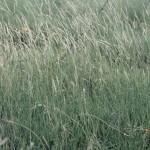Tobosa , Tobosagrass
Pleuraphis mutica Buckley
Poaceae
Description
Tobosa stems grow from coarse, woody, and scaly rootstocks, arc outward from the base, and then move back in toward the apex. Tobosa greens up readily after rain and turns ashy gray during drought. Its leaves are mostly basal, reach up to 6 inches long, are stiff and hairless, with smooth sheaths, and are prominently veined. Ligules are short, membranous, and tattered, with a few short hairs. The spike-shaped seedhead measures about 3 inches long, with 8 to 25 clusters of spikelets that drop as a unit and leave a zig-zag seedhead stem behind. The spikelets are bearded at the base, purplish to pale when ripe, sessile (stalkless), and occur in threes at each node. The glumes are fan-shaped, broad, hairy at the top and widest at the apex. Flowering may occur from April through October. Tobosa is a perennial, warm-season, rhizomatous native ranging from 12 to 24 inches or 30 to 60 cm tall. During the winter, Tobosa can form large stands of pale brownish-gray vegetation that are easy to recognize. Tobosa provides fair grazing for livestock and poor grazing for wildlife. Tobosagrass becomes unpalatable when mature, so it is lightly consumed due to its coarseness.Habitat
Tobosagrass grows most abundant in bunches on flats and in heavy, clay soils that receive runoff water. Native habitats include dry mesas, sandy or rocky slopes and plains, and alluvial flats and swales. Plant communities include desert scrub, interior chaparral, semi-desert grasslands, and woodlands.Images
Plant Characteristics
Seed Type: Non-Encapsulated
Duration: Perennial
Stem Texture: Hairless/Smooth
Growth Habit: Bunch grass, Grasses
Season: Warm
Distribution
 : 04 - Blackland Prairies, 05 - Cross Timbers and Prairies, 06 - South Texas Plains, 07 - Edwards Plateau, 08 - Rolling Plains, 09 - High Plains, 10 - Trans-Pecos
: 04 - Blackland Prairies, 05 - Cross Timbers and Prairies, 06 - South Texas Plains, 07 - Edwards Plateau, 08 - Rolling Plains, 09 - High Plains, 10 - Trans-Pecos
Distributions
Distribution refers to the ecological region in Texas that a plant has been found. You can also view a clickable map.
Book: Know Your Grasses (B-182)
Collection: Grasses


